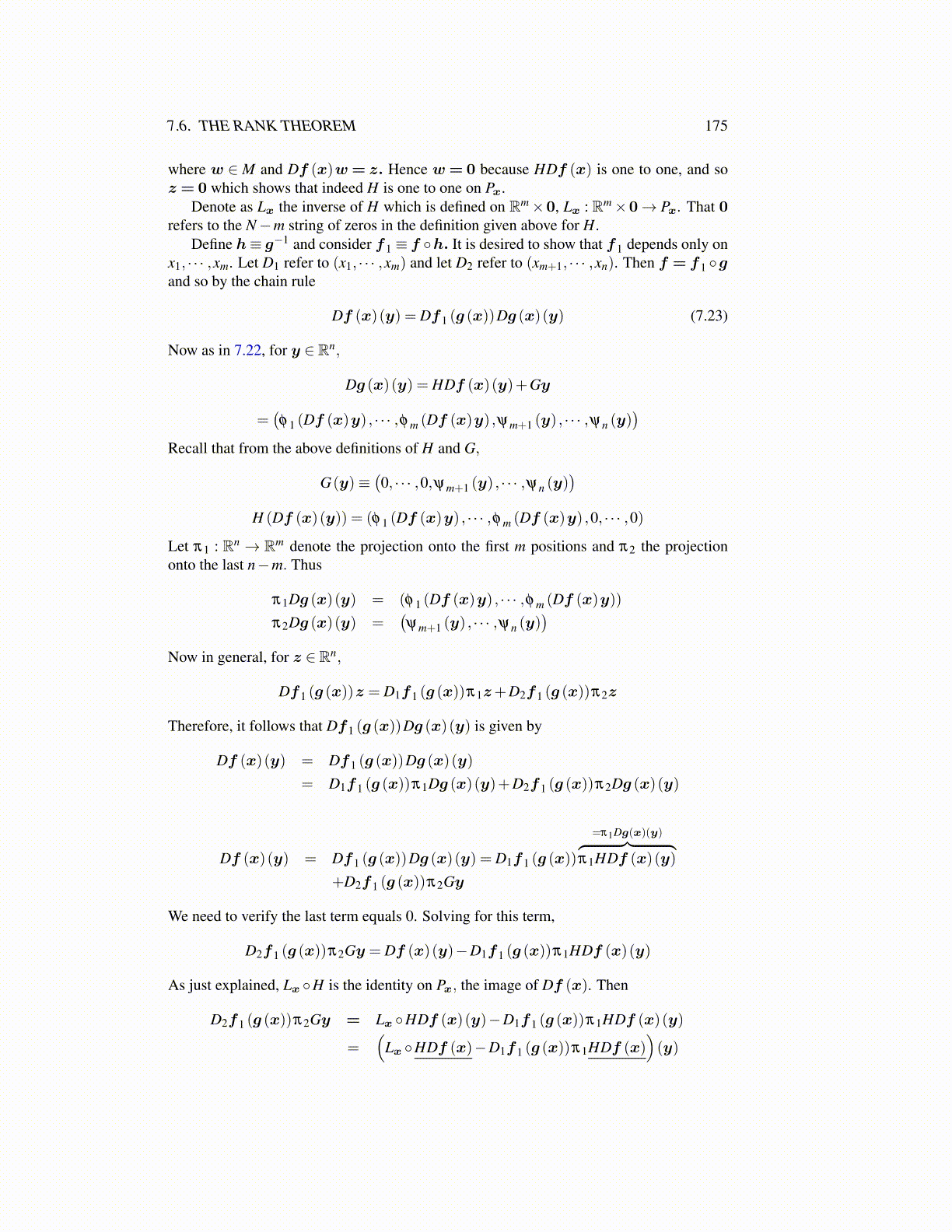
7.6. THE RANK THEOREM 175
where w ∈ M and Df (x)w= z. Hence w = 0 because HDf (x) is one to one, and soz = 0 which shows that indeed H is one to one on Px.
Denote as Lx the inverse of H which is defined on Rm×0, Lx : Rm×0→ Px. That 0refers to the N−m string of zeros in the definition given above for H.
Define h≡ g−1 and consider f1 ≡ f ◦h. It is desired to show that f1 depends only onx1, · · · ,xm. Let D1 refer to (x1, · · · ,xm) and let D2 refer to (xm+1, · · · ,xn). Then f = f1 ◦gand so by the chain rule
Df (x)(y) = Df1 (g (x))Dg (x)(y) (7.23)
Now as in 7.22, for y ∈ Rn,
Dg (x)(y) = HDf (x)(y)+Gy
=(φ 1 (Df (x)y) , · · · ,φ m (Df (x)y) ,ψm+1 (y) , · · · ,ψn (y)
)Recall that from the above definitions of H and G,
G(y)≡(0, · · · ,0,ψm+1 (y) , · · · ,ψn (y)
)H (Df (x)(y)) = (φ 1 (Df (x)y) , · · · ,φ m (Df (x)y) ,0, · · · ,0)
Let π1 : Rn → Rm denote the projection onto the first m positions and π2 the projectiononto the last n−m. Thus
π1Dg (x)(y) = (φ 1 (Df (x)y) , · · · ,φ m (Df (x)y))
π2Dg (x)(y) =(ψm+1 (y) , · · · ,ψn (y)
)Now in general, for z ∈ Rn,
Df1 (g (x))z = D1f1 (g (x))π1z+D2f1 (g (x))π2z
Therefore, it follows that Df1 (g (x))Dg (x)(y) is given by
Df (x)(y) = Df1 (g (x))Dg (x)(y)
= D1f1 (g (x))π1Dg (x)(y)+D2f1 (g (x))π2Dg (x)(y)
Df (x)(y) = Df1 (g (x))Dg (x)(y) = D1f1 (g (x))
=π1Dg(x)(y)︷ ︸︸ ︷π1HDf (x)(y)
+D2f1 (g (x))π2Gy
We need to verify the last term equals 0. Solving for this term,
D2f1 (g (x))π2Gy = Df (x)(y)−D1f1 (g (x))π1HDf (x)(y)
As just explained, Lx ◦H is the identity on Px, the image of Df (x). Then
D2f1 (g (x))π2Gy = Lx ◦HDf (x)(y)−D1f1 (g (x))π1HDf (x)(y)
=(
Lx ◦HDf (x)−D1f1 (g (x))π1HDf (x))(y)